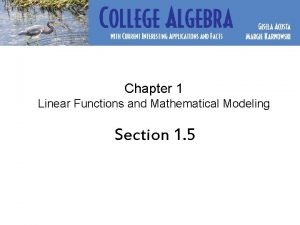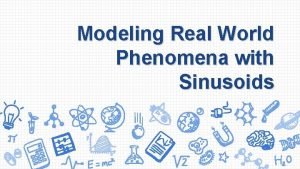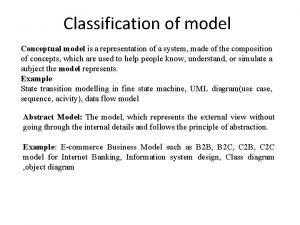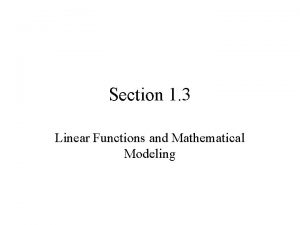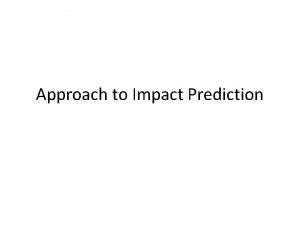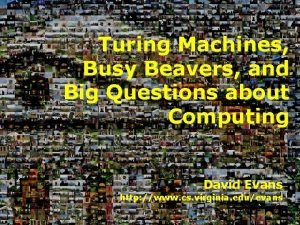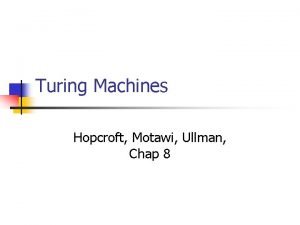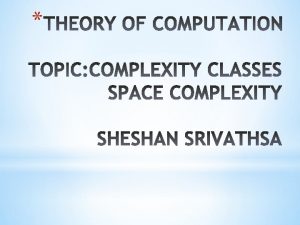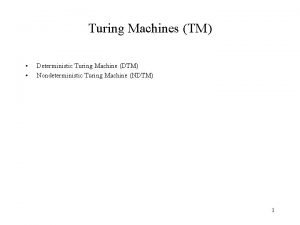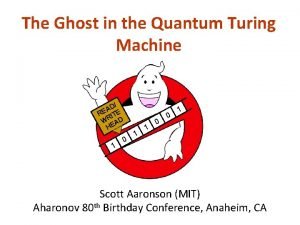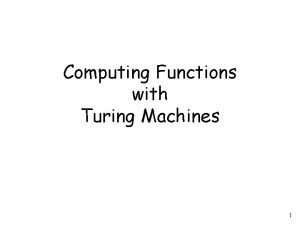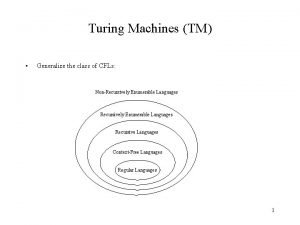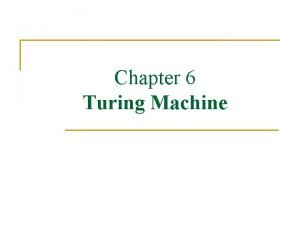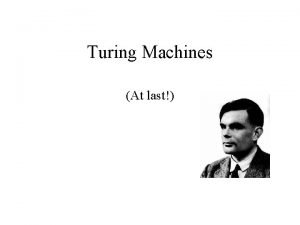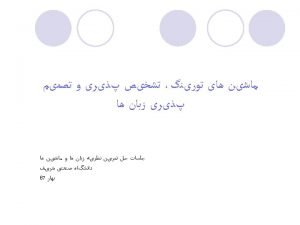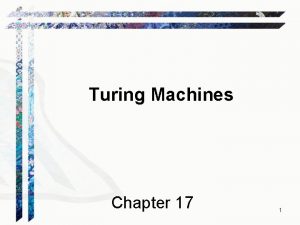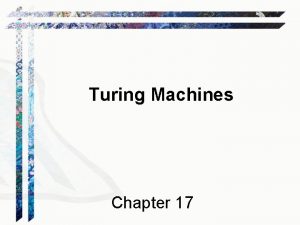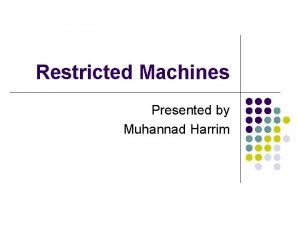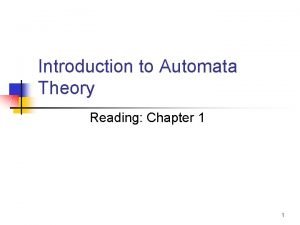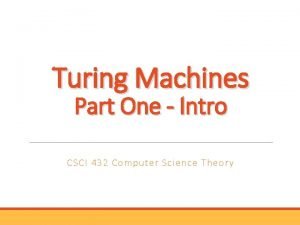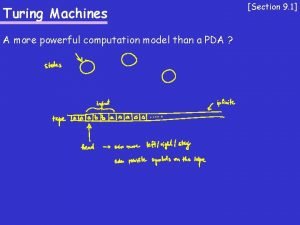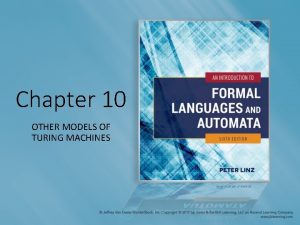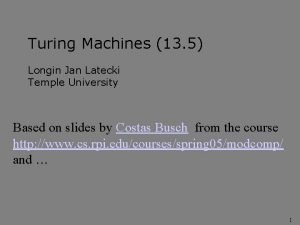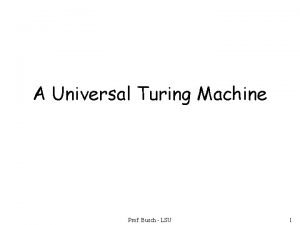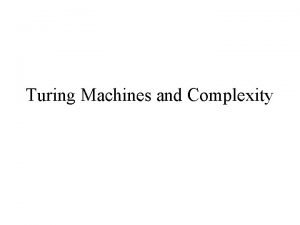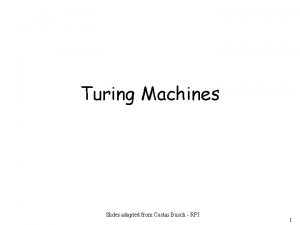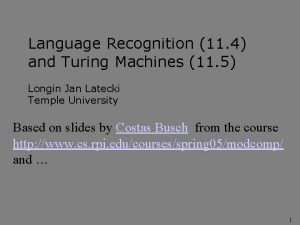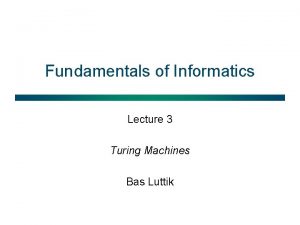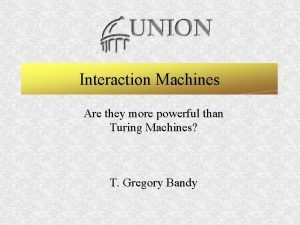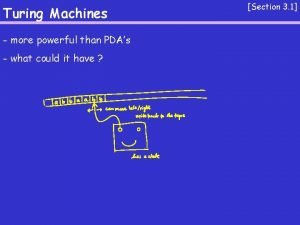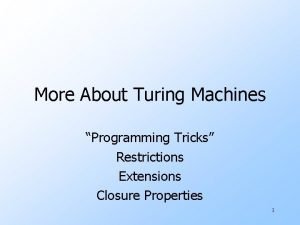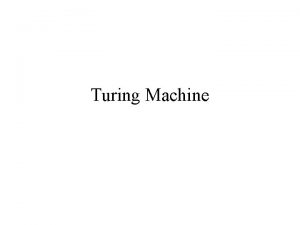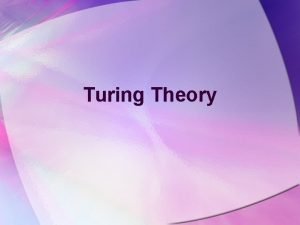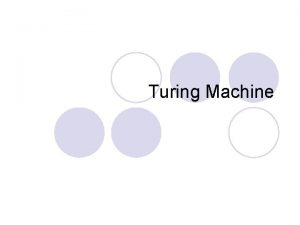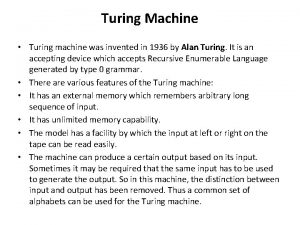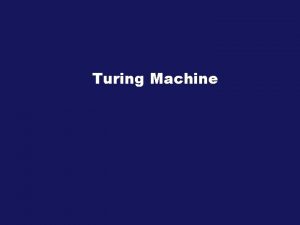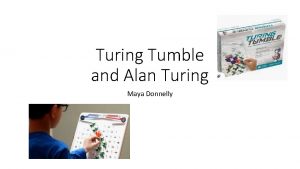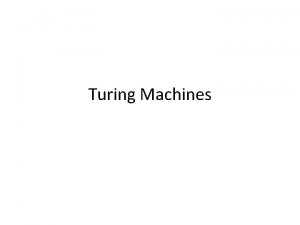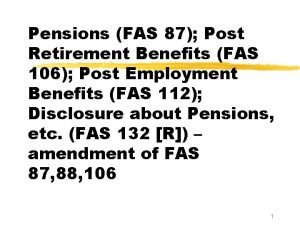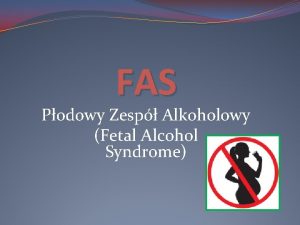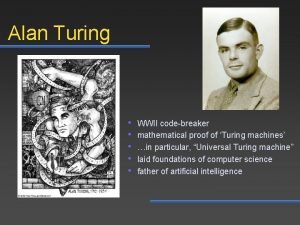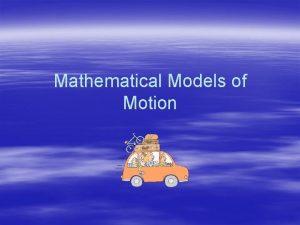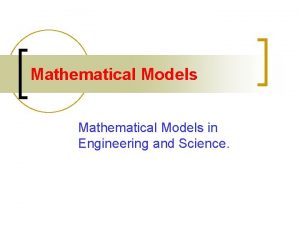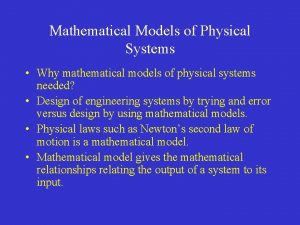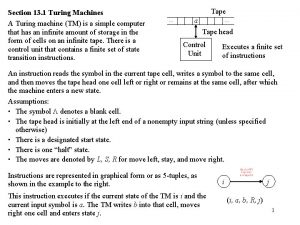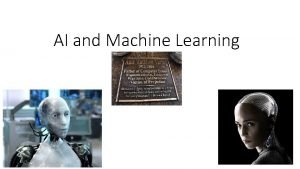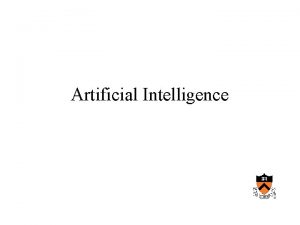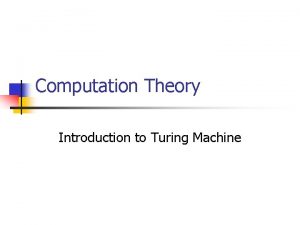Turing Machine Turing machine The mathematical models FAs





































- Slides: 37

Turing Machine

Turing machine The mathematical models (FAs, TGs, PDAs) that have been discussed so far can decide whether a string is accepted or not by them i. e. these models are language identifiers. However, there are still some languages which can’t be accepted by them e. g. there does not exist any FA or TG or PDA accepting any non. CFLs. Alan Mathison Turing developed the machines called Turing machines, which accept some non-CFLs as well, in addition to CFLs.

Turing machine Definition: A Turing machine (TM) consists of the following 1. An alphabet Σ of input letters. 2. An input TAPE partitioned into cells, having infinite many locations in one direction. The input string is placed on the TAPE starting its first letter on the cell i, the rest of the TAPE is initially filled with blanks (∆’s).

Turing machine continued … Input TAPE i a ii b iii a iv ∆ . . . TAPE Head 3. A tape Head can read the contents of cell on the TAPE in one step. It can replace the character at any cell and can reposition itself to the next cell to the right or to the left of that it has just read.

Turing machine continued … Initially the TAPE Head is at the cell i. The TAPE Head can’t move to the left of cell i. the location of the TAPE Head is denoted by. 4. An alphabet Γ of characters that can be printed on the TAPE by the TAPE Head. ΓΣ may include the letters of Σ. Even the TAPE Head can print blank ∆, which means to erase some character from the TAPE.

Turing machine continued … 5. Finite set of states containing exactly one START state and some (may be none) HALT states that cause execution to terminate when the HALT states are entered. 6. A program which is the set of rules, which show that which state is to be entered when a letter is read form the TAPE and what character is to be printed. This program is shown by the states connected by directed edges labeled by triplet (letter, direction)

Turing machine continued … It may be noted that the first letter is the character the TAPE Head reads from the cell to which it is pointing. The second letter is what the TAPE Head prints the cell before it leaves. The direction tells the TAPE Head whether to move one cell to the right, R, or one cell to the left, L. Following is a note

Note It may be noted that there may not be any outgoing edge at certain state for certain letter to be read from the TAPE, which creates nondeterminism in Turing machines. It may also be noted that at certain state, there can’t be more than one out going edges for certain letter to be read from the TAPE. The machine crashes if there is not path for a letter to be read from the TAPE and the corresponding string is supposed to be rejected.

Note continued … To terminate execution of certain input string successfully, a HALT state must be entered and the corresponding string is supposed to be accepted by the TM. The machine also crashes when the TAPE Head is instructed to move one cell to the left of cell i. Following is an example of TM

Example Consider the following Turing machine (a, a, R) (b, b, R) (a, a, R) 2 1 START (∆, ∆, R) (b, b, R) 3 4 HALT (b, b, R) Let the input string aba be run over this TM

Example continued … Input TAPE i a ii b iii a iv ∆ . . . TAPE Head Starting from the START state, reading a form the TAPE and according to the TM program, a will be printed i. e. a will be replaced by a and the TAPE Head will be moved one cell to the right.

Which can be seen as Input TAPE i a ii b iii a iv ∆ TAPE Head This process can be expressed as 1 aba 2 aba . . .

At state 2 reading b, state 3 is entered and the letter b is replaced by b, i. e. 1 2 3 aba At state 3 reading a, will keep the state of the TM unchanged. Lastly, the blank ∆ is read and ∆ is replaced by ∆ and the HALT state is entered. Which can be expressed as

1 2 3 3 HALT aba aba ∆ Which shows that the string aba is accepted by this machine. It can be observed, from the program of the TM, that the machine accepts the language expressed by (a+b)b(a+b)*.

Theorem: Every regular language is accepted by some TM. Example: Consider the EVEN-EVEN language. Following is a TM accepting the EVEN-EVEN language.

(b, b, R) 5 HALT (∆, ∆, R) 1 START (b, b, R) 2 (a, a, R) (b, b, R) 3 (b, b, R) 4 It may be noted that the above diagram is similar to that of FA corresponding to EVEN-EVEN language. Following is another example

Example Consider the following TM (b, b, R) (a, a, R) 2 (b, b, R) 3 (a, a, L) 4 (a, *, R) (∆, ∆, R) 9 HALT 1 START (b, a, R) (a, a, R) 5 (*, *, R) (∆, ∆, L) (a, a, L) (b, b, L) 8 (a, ∆, L) 7 (a, ∆, L) 6

Example continued … The string aaabbbaaa can be observed to be accepted by the above TM. It can also be observed that the above TM accepts the non -CFL {anbnan}.

INSERT subprogram Sometimes, a character is required to be inserted on the TAPE exactly at the spot where the TAPE Head is pointing, so that the character occupies the required cell and the other characters on the TAPE are moved one cell right. The characters to the left of the pointed cell are also required to remain as such.

In the situation stated above, the part of TM program that executes the process of insertion does not affect the function that the TM is performing. The subprogram of insertion is independent and can be incorporated at any time with any TM program specifying what character to be inserted at what location. The subprogram of insertion can be expressed as

INSERT a INSERT b INSERT # The above diagrams show that the characters a, b and # are to be inserted, respectively. Following is an example showing how does the subprogram INSERT perform its function

Example If the letter b is inserted at the cell where the TAPE Head is pointing as shown below. . . b X a b b X ∆ ∆. . . then, it is expressed as. . . b X a b INSERT b b X ∆ ∆. . .

The function of subprogram INSERT b can be observed from the following diagram. . . b X b a b b X ∆ ∆. . . Following is the INSERT subprogram

The subprogram INSERT Keeping in view the same example of inserting b at specified location, to determine the required subprogram, first Q will be inserted as marker at the required location, so that the TAPE Head must be able to locate the proper cell to the right of the insertion cell. The whole subprogram INSERT is given as


It is supposed that machine is at state 1, when b is to be inserted. All three possibilities of reading a, b or X are considered by introducing the states 2, 3 and 4 respectively. These states remember what letter displaced during the insertion of Q. Consider the same location where b is to be inserted

. . . b X a b b X ∆ ∆. . . After reading a from the TAPE, the program replaces a by Q and the TAPE Head will be moved one step right. Here the state 2 is entered. Reading b at state 2, b will be replaced by a and state 3 will be entered. At state 3 b is read which is not replaced by any character and the state 3 will not be left.

At state 3, the next letter to be read is X, which will be replaced by b and the state 4 will be entered. At state 4, ∆ will be read, which will be replaced by X and state 5 will be entered. At state 5 ∆ will be read and without any change state 6 will be entered, while TAPE Head will be moved one step left. The state 6 makes no change whatever (except Q) is read at that state. However at each step, the TAPE Head is moved one step left. Finally, Q is read which is replaced by b and the TAPE Head is moved to one step right.

EQUAL (X, X, R) (b, b, R) START INSERT # 6 (a, X, L) (D, D, L) (X, X, L) 10 (X, X, L) (b, b, L) 7 (#, #, R) HALT (X, X, R) (a, a, R) (X, X, L) (a, a, L) 8 (b, X, L) 9

Hence, the required situation of the TAPE can be shown as. . . b X a b b X ∆ ∆. . .

DELETE subprogram Sometimes, a character is required to be DELETED on the TAPE exactly at the spot where the TAPE Head is pointing, so that the other characters on the right of the TAPE Head are moved one cell left. The characters to the left of the pointed cell are also required to remain as such.

In the situation stated above, the part of TM program that executes the process of deletion does not affect the function that the TM is performing. The subprogram of deletion is independent and can be incorporated at any time with any TM program specifying what character to be deleted at what location. The subprogram of deletion can be expressed as

Example If the letter a is to be deleted from the string bcabbc, shown below. . . b c a b b c ∆ ∆. . . then, it is expressed as. . . b c a b DELETE b

The function of subprogram DELETE can be observed from the following diagram. . . b c b b c ∆ ∆. . . Following is the DELETE subprogram


The process of deletion of letter a from the string bcabbc can easily be checked, giving the TAPE situation as shown below. . . b c b b c ∆ ∆. . .

Summing Up Turing machine, examples, DELETE subprogram, example, INSERT subprogram, example.
 Julius mathison turing
Julius mathison turing What is mathematical economics
What is mathematical economics Linear functions as mathematical models
Linear functions as mathematical models Sinusoidal function examples in real life
Sinusoidal function examples in real life Types of mathematical models
Types of mathematical models Conceptual physical and mathematical models are used to
Conceptual physical and mathematical models are used to Linear functions as mathematical models
Linear functions as mathematical models Mathematical models for impact prediction
Mathematical models for impact prediction What is the difference between models & semi modals
What is the difference between models & semi modals Busy beaver turing machine
Busy beaver turing machine Ullman turing
Ullman turing A deterministic turing machine is: *
A deterministic turing machine is: * Nondeterministic turing machine
Nondeterministic turing machine Boltzmann brain
Boltzmann brain Tm pp
Tm pp Turing machine pseudocode
Turing machine pseudocode Halting problem of turing machine
Halting problem of turing machine Turing machine
Turing machine An id of a turing machine can be defined in terms of:
An id of a turing machine can be defined in terms of: Turing machine formal definition
Turing machine formal definition Turing machine enumerator
Turing machine enumerator Turing machine for wcw
Turing machine for wcw Godel incompleteness theorem
Godel incompleteness theorem Wcw turing machine
Wcw turing machine Multistack turing machine
Multistack turing machine Alan turing machine
Alan turing machine Turing machine examples
Turing machine examples Turing machine is more powerful than:
Turing machine is more powerful than: Multidimensional turing machine
Multidimensional turing machine Turing machine examples
Turing machine examples Turing machine
Turing machine Turing machine
Turing machine Turing macine
Turing macine Turing machine
Turing machine Morphett turing machine
Morphett turing machine Turing machine is more powerful than: *
Turing machine is more powerful than: * Tm is more powerful than pda
Tm is more powerful than pda Extensions of turing machine
Extensions of turing machine


